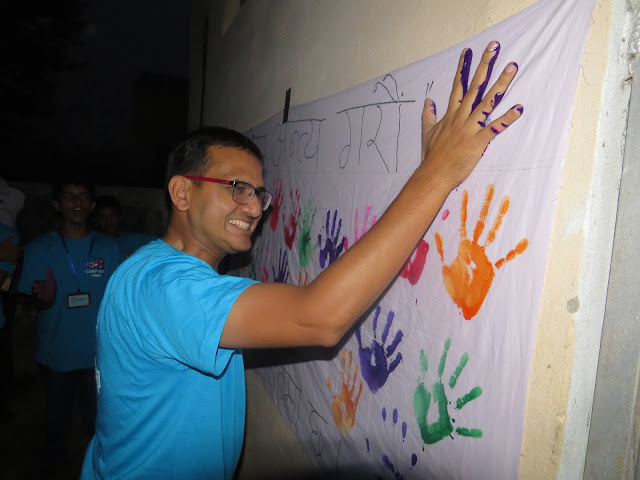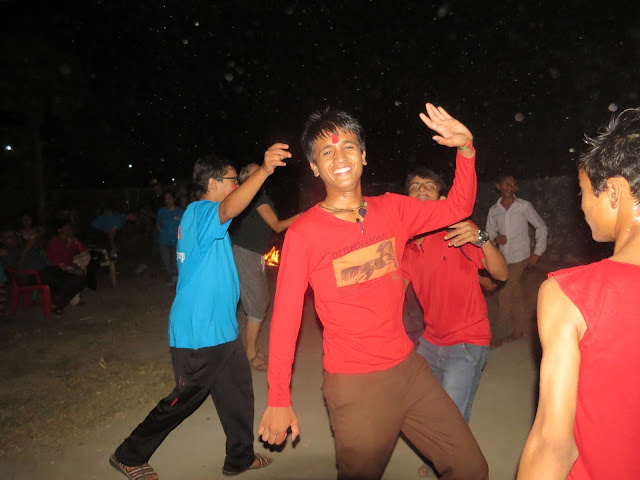Now that I’ve completed my second week at Patan Hopsital, I’ve
settled into a routine. Each morning, I arrive at 8am for morning report, at
which residents or medical students present an interesting case or two from the
previous day. After the social history, the presentation includes two components
which I have never encountered before: the patient’s concern and the patient’s
expectation (almost invariably, the concern is something like “they are not well”
and the expectation is “to go home soon”).
After the presentation and a multidisciplinary discussion, we
begin rounds. Our team, consisting of three residents, an attending, and
sometimes a fellow, cares for around twenty patients. The attendings stroll
from room to room, as the residents scramble to retrieve and replace our
patients’ paper charts. Presentations occur at bedside, in a mixture of English
and Nepali. The patient’s family features prominently in the history and plan.
Whether visiting the clinic or admitted to the hospital,
each patient carries a folder or, when the history is more substantial, a bag
filled with folders. These contain everything from outpatient and discharge notes,
to lab, echo and imaging reports, to the actual imaging films themselves, to medical
bills and receipts. During rounds, we frequently ask the family for pieces of this
record. If the patient needs rehabilitation, we ask the family to walk them
around the hospital. If blood needs to be sent to the lab, we ask a relative to
take it. If a patient needs to be transported, the family does it; if not enough
relatives are available, the test or procedure may be delayed. If the patient eats
something when they are supposed to be NPO (nothing by mouth), we may scold the
family. If no one is at the patient’s bedside, we may ask another patient’s caregiver
for assistance. For example, after drawing an arterial blood gas from an elderly
man’s radial artery, the resident asked another man—a complete stranger to our
patient—to hold pressure on the puncture site for five minutes. He did so, without
question or even gloves, as the resident left the room to carry out his other
duties.
I consider how some of these tasks may put patients or their
relatives at risk. I also wonder what family members think about being assigned
these tasks. Are they happy to assist in the care of their loved ones in whatever
way possible? Do they consider it an additional burden? Do they accept it as a
necessity of a system with limited resources? “Patients here have very low
education levels,” several doctors have noted. “They will often do exactly as
the doctor says, without questions.” In the words of another’s, “Many people view
doctors like a god.”
I’ve only identified a few factors that limit physicians doing
what they deem best. The first, and largest, is cost. Nepal provides certain
medications (about 70) for free, and is in the early stages of rolling out a national
healthcare system, but by and large patients pay their own way. Compared to the
US, most medications, tests, and procedures are relatively cheap (e.g. ~$0.30
for a liter of fluids; ~$60 for a CT), but for Nepalis with meagre earnings,
these small amounts can add up, even with the financial assistance that the
hospital offers. Providers may present choice between a test or treatment that
is first-line and one that is suboptimal but cheaper, such as a head CT instead
of a MR angiogram for our young woman with refractory epilepsy, warfarin over a
novel oral anticoagulant for our elderly stroke patient with atrial fibrillation.
In both cases, the patients and their families chose the cheaper option.
Additionally, younger and female family members may cede
decision-making to older and male relatives. For a 62-year-old man who fell after
drinking two liters of alcohol (double his regular daily intake), we advised treatment
of his alcohol use disorder and liver damage; his sons hesitated to agree to
this because of his desire to leave the hospital—despite the fact that, in his
delirium, he could not state their names, where he lived, where we were, or why
he was there, and that he was actively visually hallucinating. When a
35-year-old man was admitted for acute pancreatitis, a potentially life-threatening
illness, his wife seemed similarly torn by our recommendations and his demand
to go home, and she remained silent when he decided to leave against medical advice
(or, as it is written here, LAMA).
In addition to lack of education, poverty, and social hierarchy,
among the other social determinants of health is patient communication (much
like in the US). Take the case of a 47-year-old woman recently diagnosed
with rheumatoid arthritis (based on heel pain, treated with methotrexate,
leflunomide, hydroxychloroquine, and corticosteroids), who was admitted with
severe mouth sores, a fever (T 101), low platelets (90), low hemoglobin (7.5),
and low white blood cell count (less than 1000, with an absolute neutrophil count
around 300). Along with oral mucositis and neutropenic fever, she was diagnosed
with acute liver failure, oral candidiasis, staphylococcal skin infection, and,
a few days later, alopecia. A medical student might recognize the cause of all
these symptoms—methotrexate toxicity. Rather than taking it once a week (a dose
appropriate for rheumatoid arthritis), she had taken methotrexate daily (a dose
appropriate for cancer chemotherapy). “Completely iatrogenic,” the attending
lamented. Moreover, her foot x-ray showed a calcaneal spur, and none of her
labs were suggestive of rheumatoid arthritis. In other words, she was treated
improperly for a disease she likely didn’t even have. After a week of withholding
the medication and proper supportive care, everything besides her hair loss had
resolved, and she was discharged. Since then, two more women have presented with
almost the exact same story (although they likely do have rheumatoid arthritis).
We typically finish rounds between 11 and 1pm and then break
for lunch for an hour or so. In the afternoon, I either assist the residents as
they complete tasks for our team’s patients, or I shadow other team members at the
outpatient department, which is somewhat like an urgent care, where patients are
seen without appointments. My day concludes by 4pm, or a little later if there
are remaining tasks. The duty resident stays overnight, admitting patients,
seeing consults, and advancing care, until we all arrive the next day at 8am.
The internal medicine residents take 32-hour call every 3-4
days. There are no duty hour restrictions, no post-call days off, and, for many
weeks during the first year of residency, no days off whatsoever. In a typical
week, they work more than 90 hours. “Do you like this schedule?” I ask a
group of residents. “This is the best place to train,” they reply. “It is
better here than some other places.” Having just completed my residency
interview tour, these attitudes are not foreign to me.
The internal medicine doctors display a deep and wide range of
knowledge and skills, rarely needing to consult UpToDate or PubMed. I’ve observed
first-year residents performing renal biopsies, bone marrow biopsies, lymph
node biopsies, and joint fluid aspirations. On the floors, the generalists will
independently manage strokes, seizures, pleural tuberculosis, dilated cardiomyopathy,
and ulcerative colitis, without specialist consultations. Would patients
benefit from specialist input? Most likely. Are such services available? Generally
not.
































